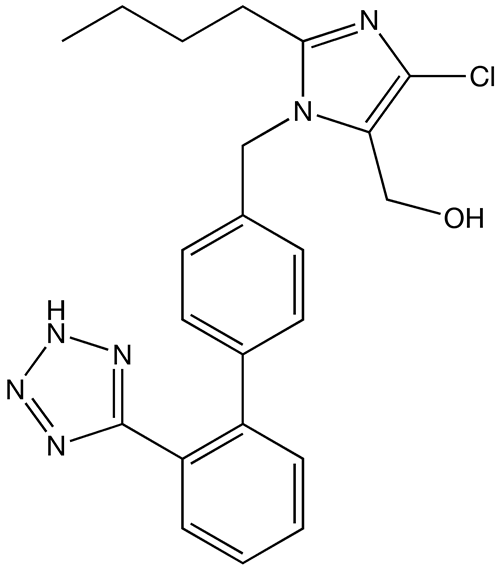Playlist
Show Playlist
Hide Playlist
Renin-Angiotensin-Aldosterone System
-
Slides 06 BloodandUrineVolume UrinarySystem.pdf
-
Download Lecture Overview
00:01 Now, let’s change gears a little bit to talk about the renin-angiotensin-aldosterone system. 00:07 So the renin-angiotensin-aldosterone system is engaged by decreases in pressure right around the juxtaglomerular apparatus. 00:16 Again, you have the release of renin, which change angiotensinogen to angiotensin I, and then the ACE, or angiotensin converting enzyme, converts angiotensin I to angiotensin II. 00:29 We will pause an angiotensin II right now because it is an active or regulated molecule and it's going to be able to enact things or change physiology. 00:41 So let’s talk through how angiotensin II changes physiology. 00:45 So angiotensin II causes afferent arteriole constriction and efferent arteriole constriction. 00:52 Interestingly, the efferent arteriole constriction happens to a greater degree. 00:58 Therefore, efferent arteriole resistance goes up a little bit more than afferent arteriole resistance. 01:04 These changes in resistance increase the filtration fraction. 01:09 By increasing filtration fraction, there’s an increase in the peritubular capillary osmotic pressure. 01:16 This increase in peritubular capillary osmotic pressure allows for more proximal sodium reabsorption. 01:23 And of course, if you increase the amount of proximal tubule reabsorption, you’re going to decrease sodium excretion. 01:30 So that revolves around retaining more sodium. 01:34 But there’s another effect of this increase in afferent and efferent arteriole resistance, and that is it decreases the peritubular capillary hydrostatic pressure. 01:46 This also increases proximal tubule reabsorption, and therefore, decreases sodium excretion. 01:54 So angiotensin II also affects renal blood flow. 01:57 This decreases the vasa recta blood flow, which decreases the washout of urea, so urea is going to increase. 02:06 And as urea increases in the interstitial fluid, this changes the gradient for sodium reabsorption, andn this does in the thin ascending limb in the loop of Henle. 02:21 What ends up happening then is there is an increase in the sodium reabsorption in the loop of Henle, and this also feeds back into the process of decreasing sodium excretion. 02:37 If you decrease sodium excretion, you decrease water excretion. 02:43 So this is how angiotensin II is involved with saving sodium and saving water. 02:51 So in terms of the locations in the nephrons of where these actions take place, these are primarily occurring at the level of the proximal tubule, and then the loop of Henle. 03:04 Those are the 2 aspects in which angiotensin II directly affects sodium reabsorption. 03:12 Now, let’s move on to the renin-angiotensin-aldosterone system. 03:17 So angiotensin II was an active molecule, meaning that it had physiological properties – aldosterone also does. 03:25 Aldosterone is released when decreases in arterial pressure, which decreases renal perfusion pressure stimulating renin release, converting to angiotensin I, angiotensin II, and finally to aldosterone. 03:40 This is the primary pathway to get an increase in the aldosterone levels. 03:45 The other stimuli for aldosterone is potassium. 03:48 So if there’s an increase in potassium concentration, this also stimulates aldosterone release. 03:55 Aldosterone is a primary molecule for the reabsorption of sodium in the distal tubule. 04:01 So let’s take a look at that. 04:03 So how does aldosterone work? To remind you of this fact, let’s go through this process. 04:08 So aldosterone is going to stimulate a number of peptides and proteins. 04:14 Those proteins are going to have functions. 04:16 The one protein is the sodium-potassium ATPase, which is going to set up a driving force from the tubule lumen side all the way up to the basolateral side. 04:28 It also adds ENaC sodium channels, which allows the transport of sodium across the apical membrane, and then at ROMK channels allow the secretion of potassium. 04:40 So in this case, we have 3 proteins that were expressed – the sodium-potassium ATPase, the ENaC sodium channel, and the ROMK channel. 04:50 The ENaC sodium channel and the ROMK channel are on the apical membrane and the basolateral sodium-potassium ATPase. 04:58 So that’s how aldosterone will enact its change in sodium reabsorption.
About the Lecture
The lecture Renin-Angiotensin-Aldosterone System by Thad Wilson, PhD is from the course Urinary Tract Physiology.
Included Quiz Questions
Which of the following would NOT be expected as a result of an increase in angiotensin II ?
- Increased sodium excretion
- Increased filtration fraction
- Increase in plasma sodium level
- Increased osmotic pressure
- Decreased urea release
At which of the following locations does aldosterone act to increase sodium reabsorption?
- Principal cells
- Tubular cells of the proximal convoluted tubule
- Myocytes in the afferent arteriole
- Tubular cells in the loop of Henle
Which of the following statements is TRUE regarding sodium reabsorption in the kidney?
- ENaC channels are located at the apical membrane.
- The sodium-potassium pump increases sodium ions in tubule cells.
- ENaC cells channel sodium ions out of tubule cells.
- ROMK channels are located in the basolateral membrane.
- Aldosterone increases sodium ion concentration in the tubule lumen.
Customer reviews
5,0 of 5 stars
| 5 Stars |
|
5 |
| 4 Stars |
|
0 |
| 3 Stars |
|
0 |
| 2 Stars |
|
0 |
| 1 Star |
|
0 |






